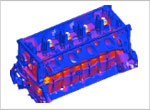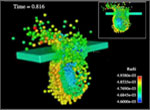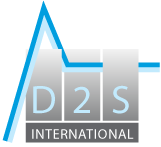Désolé – cette page n’existe pas en français.
La page recherchée n’est pas traduite dans la langue sélectionnée.
Ci-dessous vous trouverez la page en anglais.
Integrated CAE for Improved Accuracy
At most companies, CAE is performed as an isolated activity within a single functional team or engineering discipline. The performance, safety, and reliability of their products, however, is greatly influenced by the interactions between these disciplines. Multiphysics FEA can account for some of these interactions, but often the mathematical basis for disciplines are fundamentally different. Multibody dynamics, FEA, and controls systems models, for example, do not share the same numerical foundation, making it difficult to evaluate products from a true system level perspective.
Multidiscipline CAE enables CAE applications from nearly any mathematical regime to share data that enables system level modeling and analysis. More than multiphysics, MD makes it possible to integrate FEA, controls, multibody dynamics, finite difference, closed form equations, and more, to enable co-simulation across the boundaries of engineering disciplines. Multidiscipline solutions (MD) from Hexagon’s (MSC Software) MD Solutions offer interactive analysis for coupled engineering physics such as motion-structures, thermal mechanical, systems and controls, multi-physics, fluid-structure interaction (FSI), composites failure chaining, implicit-explicit, and more. Our robust solver foundation allows engineers to solve the most complex engineering challenges. Depending on the type of analysis, engineers can use MD solutions in two ways – direct coupling (applying multiple physics to the model simultaneously) or automatic chaining (passing load cases from one analysis to the next).






Hexagon’s (MSC Software) multidiscipline solutions include:
Motion-Structural Analysis
Motion analysis provides an efficient solution by enabling designers to predict the kinematic (displacements, velocities and accelerations) and dynamic (forces and moments) behavior of mechanical assemblies. Although a motion solution is well suited for predicting overall system behavior, it typically approximates the structural components to be rigid. Consequently, motion analysis does not predict deformations or stresses in individual components of an assembly.
Finite element analysis, on the other hand, can include linear and nonlinear material characteristics of individual components in an assembly, and therefore provides detailed insight into component behavior, including prediction of stress and potential failure. Modeling an entire assembly for system response prediction with finite elements, however, can be cost prohibitive due to large compute system resource requirements and relatively long CPU computation times.
An integrated motion-structures solution from Hexagon (MSC Software) offers the best of both worlds: a simple, robust motion model with selected flexible finite element components. Our motion-structures solution is built from two of Hexagon’s (MSC Software) core solvers, Adams and Nastran. Nastran is the world’s leading software for FEA of structural and mechanical systems. By integrating these two technologies within the common user environment, Hexagon (MSC Software) delivers unparalleled efficiency and accuracy for the multidisciplinary (MD) solution of motion-structures problems.


When designing a mechanical system such as an automobile suspension, an aircraft landing gear or a fork-lift it is critical to understand how various components (pneumatics, hydraulics, electronics, and so on) interact as well as what forces (noise, vibration, and harshness) those components generate during operation. Unfortunately, even today, a lot of time and effort is spent on testing physical prototypes without virtually exploring numerous designs to optimize full-system performance.
Adams/Mechatronics can be used to directly incorporate control systems into mechanical models by dynamically linking an external system library from a controls application, such as EASY5 and MATLAB, into Adams. It makes the process of performing complete system level investigations like complex vehicle-controller interaction more straightforward. Control system parameters can be quickly adjusted for evaluation and included in a design study for simultaneous optimization of both control system and mechanical system.


Thermal Mechanical
Understanding the impact of thermal changes and structural responses is important to ensure quality and reliable long term operation for many products. Depending on the size of thermal changes and the materials involved, temperature changes can lead to warping with many unwanted consequences. For example, friction as applied in brake systems creates heat in some areas of the disc structure and these temperature changes may lead to warping which may then be the cause of unwanted noise.
Hexagon’s (MSC Software) thermal-mechanical solutions within MD Nastran give engineers the ability to simulate the interaction and effects of structural mechanics and thermal conditions, all within a single software product.


Multiphysics
Multi-physics simulation from Hexagon (MSC Software) provides a range of engineering analysis solutions that enable accurate simulation of complex coupled-physics behavior. Steadily growing demand for better performance and improved reliability of complex products and their related manufacturing processes require virtual tests capable of considering multiple physical effects that impact this product including how different physics interact. To achieve dependable, realistic simulation results that allow better design decisions, coupled simulations of the physical effects involved become necessary.
Hexagon’s (MSC Software) multi-physics solutions can accurately simulate the behavior of products simultaneously exposed to various loads, including forces, pressures, fluid flow, thermal, electro-static and electro-magnetic effects. Coupled multi-physics simulations deliver valuable insights into product performance and manufacturability helping with the quest for improved designs.


Implicit-Explicit-Implicit
Hexagon (MSC Software) provides multidiscipline solutions for integrated implicit-explicit-implicit analysis tailored for more accurate and efficient simulations of aero engine fan blade-out (FBO) events using MD Nastran.
A FBO event can be extremely nonlinear because of the heavy wide chord fan blades incorporated in the new generation of high by-pass ratio jet engines. New wide chord blades are used to meet airframe manufacturers’ demand for higher thrust engines with improved performance and optimum weight. Airframe and engine manufacturers use computerized analysis procedures to support the design of both the propulsion system and adjacent wing structures.
However, the manufactures do not share their finite element models and traditionally resort to construction of a new model to suit their analysis objective. For example, typical FBO models are very detailed and can exceed two or three million elements whereby a rotor dynamics models is much coarser and can be under 50,000 elements. So the challenge becomes as how to transfer the FBO loads computed by Hexagon’s (MSC Software) explicit solver based on a very fine meshed model to a coarse model for rotor dynamics simulation, all within one common modeling environment.
Hexagon’s (MSC Software) MD Nastran provides an automated, multidisciplinary simulation solution to streamline the FBO event simulation all within a single modeling environment. The MD Nastran master database is tailored to include only the FBO loads and other relevant information required for rotor dynamics simulation without compromising the confidentiality of the model geometry and modeling details.



Fluid-Structure Interaction (FSI)
The objective of modeling fluids in a structural analysis is to account for the influence of fluid pressures on the structure and for improved accuracy in structural response prediction. Structures are generally modeled using Lagrangian scheme where material is tied to a finite element mesh. On the other hand, fluids are solved with Eulerian scheme with material being independent of the mesh, but instead flowing through the mesh. Dual schemes are required because of the way structures and fluids behave.
When fluids and structures need to be modeled in a single analysis, the challenge is running these different schemes in a single run. This is accomplished through an automatic coupling algorithm, where two meshes – one for structure and another for fluid, exist. A coupling surface is created between these two domains which acts as a boundary to the flow of material in Eulerian mesh, while enabling transfer of the stresses to the Lagrangian structural mesh causing it to deform.
With problems that include fluids and gases interacting with structures, or explosions, and highly nonlinear structural materials, Hexagon’s (MSC Software) MD Nastran solution gives engineers a robust set of capabilities to accurately address these issue within a single tool. Our FSI solutions are used for simulating complex models like air bags, gas tank sloshing, hydroplaning, underwater explosions, bottle filling, blood bag drop tests, and more.



Demande d’information
D2S International offre des services de conseil en utilisant le logiciel d’éléments finis de HEXAGON (MSC Software).
